Eco-Friendly Poly (Butylene Adipate-co-Terephthalate) Coated Bi-Layered Films: An Approach to Enhance Mechanical and Barrier Properties
Abstract
:1. Introduction
2. Materials and Methods
2.1. Materials
2.2. Fabrication of PBAT Film-Coated Paper
2.3. Characterization
2.3.1. Thickness Measurements
2.3.2. Structure and Morphological Studies
2.3.3. Thermal Characterization
2.3.4. Mechanical Properties
2.3.5. Porosity and Water Absorption
2.3.6. Barrier Properties
2.3.7. Water Contact Angle (WCA) Measurements
2.3.8. Statistical Analysis
3. Results and Discussion
3.1. Structural Analysis
3.2. Morphological Analysis
3.3. Thermal Analysis
3.4. Thickness and Tensile Strength
3.5. Porosity and Water Absorption Value
3.6. Barrier Properties
3.7. Water Contact Angle Analysis
3.8. Food Quality Test of Tomatoes
4. Conclusions
Author Contributions
Funding
Institutional Review Board Statement
Data Availability Statement
Acknowledgments
Conflicts of Interest
References
- Deshwal, G.K.; Panjagari, N.R.; Alam, T. An overview of paper and paper-based food packaging materials: Health safety and environmental concerns. J. Food Sci. Technol. 2019, 56, 4391–4403. [Google Scholar] [CrossRef] [PubMed]
- Wu, F.; Misra, M.; Mohanty, A.K. Challenges and new opportunities on barrier performance of biodegradable polymers for sustainable packaging. Prog. Polym. Sci. 2021, 117, 101395. [Google Scholar] [CrossRef]
- Mujtaba, M.; Lipponen, J.; Ojanen, M.; Puttonen, S.; Vaittinen, H. Trends and challenges in the development of bio-based barrier coating materials for paper/cardboard food packaging: A review. Sci. Total Environ. 2022, 851, 158328. [Google Scholar] [CrossRef] [PubMed]
- Asgher, M.; Qamar, S.A.; Bilal, M.; Iqbal, H.M.N. Bio-based active food packaging materials: Sustainable alternative to conventional petrochemical-based packaging materials. Food Res. Int. 2020, 137, 109625. [Google Scholar] [CrossRef]
- Mori, R. Replacing all petroleum-based chemical products with natural biomass-based chemical products: A tutorial review. RSC Sustain. 2023, 1, 179–212. [Google Scholar] [CrossRef]
- Mendes, A.C.; Pedersen, G.A. Perspectives on sustainable food packaging: – is bio-based plastics a solution? Trends Food Sci. Technol. 2021, 112, 839–846. [Google Scholar] [CrossRef]
- Davis, G.; Song, J.H. Biodegradable packaging based on raw materials from crops and their impact on waste management. Ind. Crops Prod. 2006, 23, 147–161. [Google Scholar] [CrossRef]
- Moshood, T.D.; Nawanir, G.; Mahmud, F.; Mohamad, F.; Ahmad, M.H.; AbdulGhani, A. Sustainability of biodegradable plastics: New problem or solution to solve the global plastic pollution? Curr. Res. Green. Sustain. Chem. 2022, 5, 100273. [Google Scholar] [CrossRef]
- Shaghaleh, H.; Xu, X.; Wang, S. Current progress in production of biopolymeric materials based on cellulose, cellulose nanofibers, and cellulose derivatives. RSC Adv. 2018, 8, 825–842. [Google Scholar] [CrossRef] [PubMed]
- Singh, N.; Ogunseitan, O.A.; Wong, M.H.; Tang, T. Sustainable materials alternative to petrochemical plastics pollution: A review analysis. Sustain. Horiz. 2022, 2, 100016. [Google Scholar] [CrossRef]
- Kong, U.; Mohammad Rawi, N.F.; Tay, G.S. The potential applications of reinforced bioplastics in various industries: A review. Polymers 2023, 15, 2399. [Google Scholar] [CrossRef] [PubMed]
- Rani, L.; Thapa, K.; Kanojia, N.; Sharma, N.; Singh, S.; Grewal, A.S.; Srivastav, A.L.; Kaushal, J. An extensive review on the consequences of chemical pesticides on human health and environment. J. Clean. Prod. 2021, 283, 124657. [Google Scholar] [CrossRef]
- Venkatesan, R.; Rajeswari, N. Preparation, mechanical and antimicrobial properties of SiO2/poly(butylene adipate-co-terephthalate) films for active food packaging. Silicon 2019, 11, 2233–2239. [Google Scholar] [CrossRef]
- Czarnecka, E.; Walczak, M.; Kumar, G.; Piechota, G.; Nowaczyk, J. Degradation of biodegradable diapers as an element circular economy in waste containing various plastics. J. Clean. Prod. 2022, 377, 134426. [Google Scholar] [CrossRef]
- Afshar, S.V.; Boldrin, A.; Astrup, T.F.; Daugaard, A.E.; Hartmann, N.N. Degradation of biodegradable plastics in waste management systems and the open environment: A critical review. J. Clean. Prod. 2023, 434, 140000. [Google Scholar] [CrossRef]
- Venkatesan, R.; Vetcher, A.A.; Al-Asbahi, B.A.; Kim, S.-C. Chitosan-based films blended with tannic acid and moringa oleifera for application in food packaging: The preservation of strawberries (Fragaria ananassa). Polymers 2024, 16, 937. [Google Scholar] [CrossRef] [PubMed]
- Venkatesan, R.; Sivaprakash, P.; Kim, I.; Tawfeek, A.M.; Kim, S.-C. Green synthesis of carbon nanoparticle-reinforced nanocomposites with gallic acid as a crosslinking agent on poly(butylene adipate-co-terephthalate): Preparation, characterization, and performances. Ind. Crops Prod. 2024, 209, 117949. [Google Scholar] [CrossRef]
- Samir, A.; Ashour, F.H.; Hakim, A.A.A.; Bassyouni, M. Recent advances in biodegradable polymers for sustainable applications. NPJ Mater. Degrad. 2022, 6, 68. [Google Scholar] [CrossRef]
- Rajendran, N.; Han, J. Techno-economic analysis and life cycle assessment of poly (butylene succinate) production using food waste. Waste Manag. 2023, 156, 168–176. [Google Scholar] [CrossRef] [PubMed]
- Naser, A.Z.; Deiab, I.; Darras, I.B.M. Poly(lactic acid) (PLA) and polyhydroxyalkanoates (PHAs), green alternatives to petroleum-based plastics: A review. RSC Adv. 2021, 11, 17151–17196. [Google Scholar] [CrossRef] [PubMed]
- Jang, Y.; Kim, K.N.; Woo, J.R. Post-consumer plastic packaging waste from online food delivery services in South Korea. Waste Manag. 2023, 156, 177–186. [Google Scholar] [CrossRef] [PubMed]
- Li, J.; Lai, L.; Wu, L.; Severtson, S.J.; Wang, W.-J. Enhancement of water vapor barrier properties of biodegradable poly(butylene adipate-co-terephthalate) films with highly oriented organomontmorillonite. ACS Sustain. Chem. Eng. 2018, 6, 6654–6662. [Google Scholar] [CrossRef]
- Adibi, A.; Valdesueiro, D.; Simon, L.; Lenges, C.P.; Mekonnen, T.H. High barrier sustainable paper coating based on engineered polysaccharides and natural rubber. ACS Sustain. Chem. Eng. 2022, 10, 10718–10732. [Google Scholar] [CrossRef]
- Lamsaf, H.; Singh, S.; Pereira, J.; Poças, F. Multifunctional properties of PBAT with hemp (Cannabis sativa) micronised fibres for food packaging: Cast films and coated paper. Coatings 2023, 13, 1195. [Google Scholar] [CrossRef]
- Jian, J.; Xiangbin, Z.; Xianbo, H. An overview on synthesis, properties and applications of poly(butylene-adipate-co-terephthalate)–PBAT. Adv. Ind. Eng. Polym. Res. 2020, 3, 19–26. [Google Scholar] [CrossRef]
- Venkatesan, R.; Zhang, Y.; Chen, G. Preparation of poly(butylene adipate-co-terephthalate)/ZnSnO3 composites with enhanced antimicrobial activity. Compos. Commun. 2020, 22, 100469. [Google Scholar] [CrossRef]
- Venkatesan, R.; Rajeswari, N. ZnO/PBAT nanocomposite films: Investigation on the mechanical and biological activity for food packaging. Polym. Adv. Technol. 2017, 28, 20–27. [Google Scholar] [CrossRef]
- Venkatesan, R.; Rajeswari, N. Nanosilica-reinforced poly(butylene adipate-co-terephthalate) nanocomposites: Preparation, characterization and properties. Polym. Bull. 2019, 76, 4785–4801. [Google Scholar] [CrossRef]
- Camani, P.H.; Souza, A.G.; Barbosa, R.F.S.; Zanini, N.C.; Mulinari, D.R.; Rosa, D.S. Comprehensive insight into surfactant modified-PBAT physico-chemical and biodegradability properties. Chemosphere 2021, 269, 128708. [Google Scholar] [CrossRef] [PubMed]
- Kunam, P.K.; Ramakanth, D.; Akhila, K.; Gaikwad, K.K. Bio-based materials for barrier coatings on paper packaging. Biomass Convers. Biorefin. 2022. [Google Scholar] [CrossRef] [PubMed]
- Wang, F.-J.; Wang, L.-Q.; Zhang, X.-C.; Ma, S.-F.; Zhao, Z.-C. Study on the barrier properties and antibacterial properties of cellulose-based multilayer coated paper used for fast food packaging. Food Biosci. 2022, 46, 101398. [Google Scholar] [CrossRef]
- Zhang, Y.; Duan, C.; Bokka, S.K.; He, Z.; Ni, Y. Molded fiber and pulp products as green and sustainable alternatives to plastics: A mini review. J. Bioresour. Bioprod. 2022, 7, 14–25. [Google Scholar] [CrossRef]
- Andersson, C. New ways to enhance the functionality of paper by surface treatment—A review. Packag. Technol. Sci. 2008, 21, 339–373. [Google Scholar] [CrossRef]
- Shanmugam, K.; Doosthosseini, H.; Varanasi, S.; Garnier, G.; Batchelor, W. Nanocellulose films as air and water vapour barriers: A recyclable and biodegradable alternative to polyolefin packaging. Sustain. Mater. Technol. 2019, 22, e00115. [Google Scholar] [CrossRef]
- Venkatesan, R.; Alagumalai, K.; Kim, S.-C. Preparation and performance of biodegradable poly(butylene adipate-co-terephthalate) composites reinforced with novel AgSnO2 microparticles for application in food packaging. Polymers 2023, 15, 554. [Google Scholar] [CrossRef] [PubMed]
- Venkatesan, R.; Alagumalai, K.; Raorane, C.J.; Raj, V.; Shastri, D.; Kim, S.-C. Morphological, mechanical, and antimicrobial properties of PBAT/poly(methyl methacrylate-co-maleic anhydride)–SiO2 composite films for food packaging applications. Polymers 2023, 15, 101. [Google Scholar] [CrossRef] [PubMed]
- Venkatesan, R.; Vanaraj, R.; Alagumalai, K.; Asrafali, S.P.; Raorane, C.J.; Raj, V.; Kim, S.-C. Thermoplastic starch composites reinforced with functionalized POSS: Fabrication, characterization, and evolution of mechanical, thermal and biological activities. Antibiotics 2022, 11, 1425. [Google Scholar] [CrossRef] [PubMed]
- Venkatesan, R.; Rajeswari, N. TiO2 nanoparticles/poly(butylene adipate-co-terephthalate) bionanocomposite films for packaging applications. Polym. Adv. Technol. 2017, 28, 1699–1706. [Google Scholar] [CrossRef]
- Venkatesan, R.; Sivaprakash, P.; Kim, I.; Eldesoky, G.E.; Kim, S.-C. Tannic acid as a crosslinking agent in poly(butylene adipate-co-terephthalate) composite films enhanced with carbon nanoparticles: Processing, characterization, and antimicrobial activities for food packaging. J. Environ. Chem. Eng. 2023, 11, 110194. [Google Scholar] [CrossRef]
- TAPPT T494; Tensile Properties of Paper and Paperboard. TAPPI Standard: Black Mountain, NC, USA, 2013.
- TAPPI T403; Bursting Strength of Paper. TAPPI Standard: Black Mountain, NC, USA, 1997.
- TAPPI T456; Water-Saturated Paper and Paper Tensile Testing. TAPPI Standard: Black Mountain, NC, USA, 2018.
- ASTM D3985; Standard Test Method for Oxygen Transmission Rate (OTR) of Paper and Board. ASTM International: West Conshohocken, PA, USA, 2010.
- ASTM F1249; Standard Test Method for Water Vapor Transmission Rate (WVTR) of Paper and Board. ASTM International: West Conshohocken, PA, USA, 2020.
- Poulose, S.; Toriseva, J.; Lahti, J.; Jönkkäri, I.; Hedenqvist, M.S.; Kuusipalo, J. A green high barrier solution for paperpackaging based on potato fruit juice, poly(lactic acid), and poly(butylene adipate terephthalate). ACS Appl. Polym. Mater. 2022, 4, 4179–4188. [Google Scholar] [CrossRef]
- Shankar, S.; Rhim, J.W. Effects of poly(butylene adipate-co-terephthalate) coating on the water resistant, mechanical, and antibacterial properties of Kraft paper. Prog. Org. Coat. 2018, 123, 153–159. [Google Scholar] [CrossRef]
- Hashmi, A.W.; Mali, H.S.; Meena, A.; Saxena, K.K.; Ahmad, S.; Agrawal, M.K.; Sagbas, B.; Puerta, A.P.V.; Khan, M.I. A comprehensive review on surface post-treatments for freeform surfaces of bio-implants. J. Mater. Res. Technol. 2023, 23, 4866–4908. [Google Scholar] [CrossRef]
- Pietrosanto, A.; Scarfato, P.; Maio, L.D.; Nobile, M.R.; Incarnato, L. Evaluation of the suitability of poly(lactide)/poly(butylene-adipate-co-terephthalate) blown films for chilled and frozen food packaging applications. Polymers 2020, 12, 804. [Google Scholar] [CrossRef] [PubMed]
- Shankar, A.; Abdul Malik, A.K.; Narayan, R.; Chakrabarty, A. Emulsion polymerized styrene acrylic/nanocellulose composite coating to improve the strength and hydrophobicity of kraft paper. Prog. Org. Coat. 2023, 182, 107634. [Google Scholar] [CrossRef]
- Alexandersson, M.; Ristinmaa, M. Multiphase transport model of swelling cellulose-based materials with variable hydrophobicity. Int. J. Eng. Sci. 2019, 141, 112–140. [Google Scholar] [CrossRef]
- Christophliemk, H.; Bohlin, E.; Emilsson, P.; Järnström, L. Surface analyses of thin multiple layer barrier coatings of poly(vinyl alcohol) for paperboard. Coatings 2023, 13, 1489. [Google Scholar] [CrossRef]
- Sundar, N.; Ananda Kumar, S.; Pavithra, A.; Ghosh, S. Studies on semi-crystalline poly lactic acid (PLA) as a hydrophobic coating material on kraft paper for imparting barrier properties in coated abrasive applications. Prog. Org. Coat. 2020, 145, 105682. [Google Scholar]
- Youssef, A.M.; Kamel, S.; El-Samahy, M.A. Morphological and antibacterial properties of modified paper by PS nanocomposites for packaging applications. Carbohydr. Polym. 2013, 98, 1166–1172. [Google Scholar] [CrossRef] [PubMed]
- Naitzel, T.d.C.; Garcia, V.A.d.S.; Lourenço, C.A.M.; Vanin, F.M.; Yoshida, C.M.P.; Carvalho, R.A.d. Properties of paper coated with natural polymers and polymer blends: Effect of the number of coating layers. Foods 2023, 12, 2745. [Google Scholar] [CrossRef] [PubMed]
- Venkatesan, R.; Surya, S.; Suganthi, S.; Muthuramamoorthy, M.; Pandiaraj, S.; Kim, S.-C. Biodegradable composites from poly(butylene adipate-co-terephthalate) with carbon nanoparticles: Preparation, characterization and performances. Environ. Res. 2023, 235, 116634. [Google Scholar] [CrossRef] [PubMed]
- Venkatesan, R.; Sana, S.S.; Al-Asbahi, B.A.; Kim, S.-C. Fabrication of poly(butylene adipate-co-terephthalate) based films incorporated with carbon nanoparticles: Postharvest shelf-life extension of green chilies (Capsicum annuum L.). Postharvest Biol. Technol. 2024, 209, 112724. [Google Scholar] [CrossRef]
- Solberg, A.; Zehner, J.; Somorowsky, F.; Rose, K.; Korpela, A.; Syverud, K. Material properties and water resistance of inorganic–organic polymer coated cellulose paper and nanopaper. Cellulose 2023, 30, 1205–1223. [Google Scholar] [CrossRef]
- Kan, L.; Zhang, X.; Huang, Q.; Wang, Y.; Tian, M.; Huang, Q.; Wei, W.; Zhang, F.; Wang, X. Fabrication of cellulose-based and fluorine/silane free superhydrophobic paper by a green and sustainable approach. Ind. Crops Prod. 2023, 203, 117226. [Google Scholar] [CrossRef]
- Mousavi, S.M.M.; Afra, E.; Tajvidi, M.; Bousfield, D.W.; Dehghani-Firouzabadi, M. Application of cellulose nanofibril (CNF) as coating on paperat moderate solids content and high coating speed using blade coater. Prog. Org. Coat. 2018, 122, 207–218. [Google Scholar] [CrossRef]
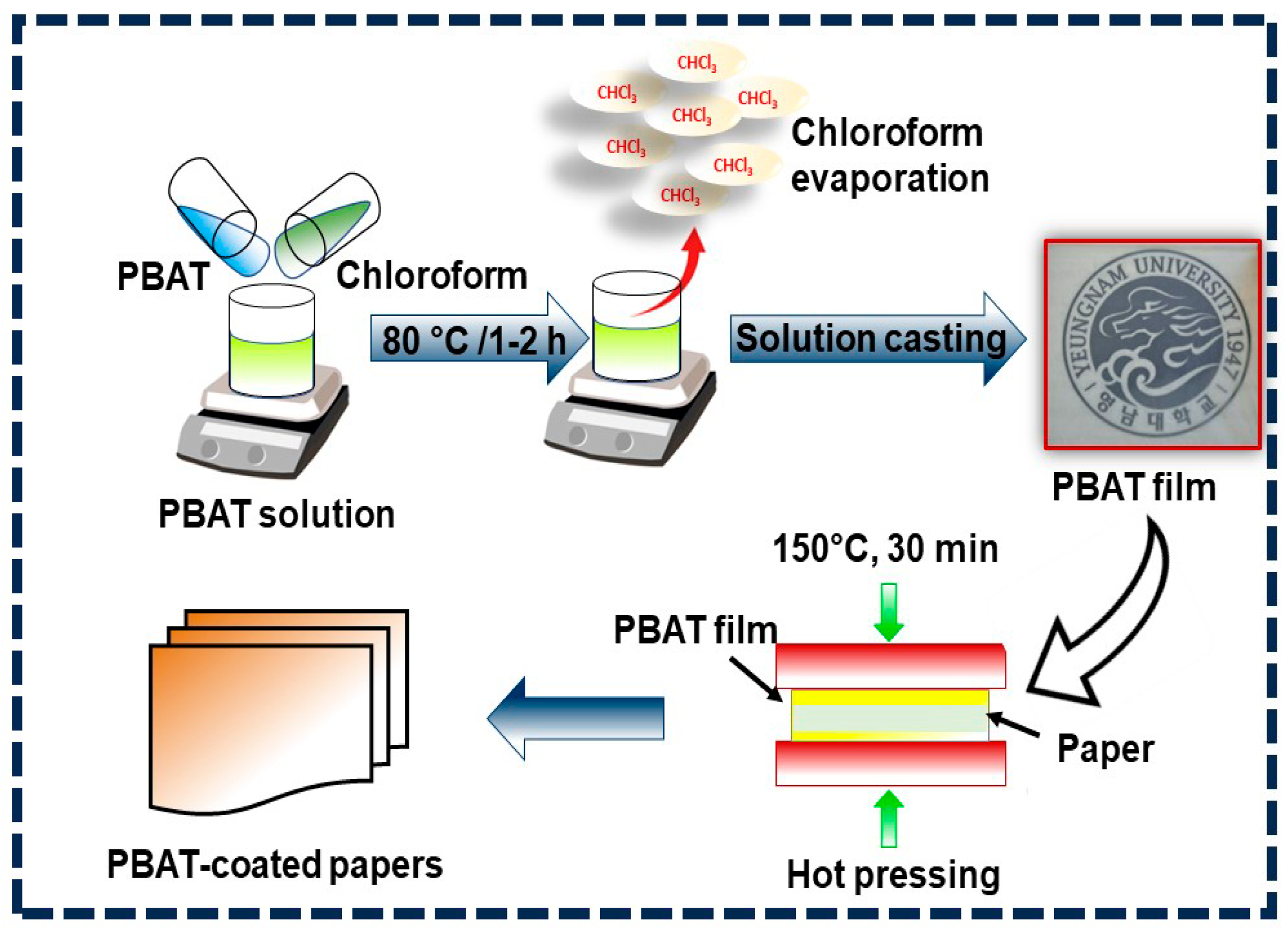
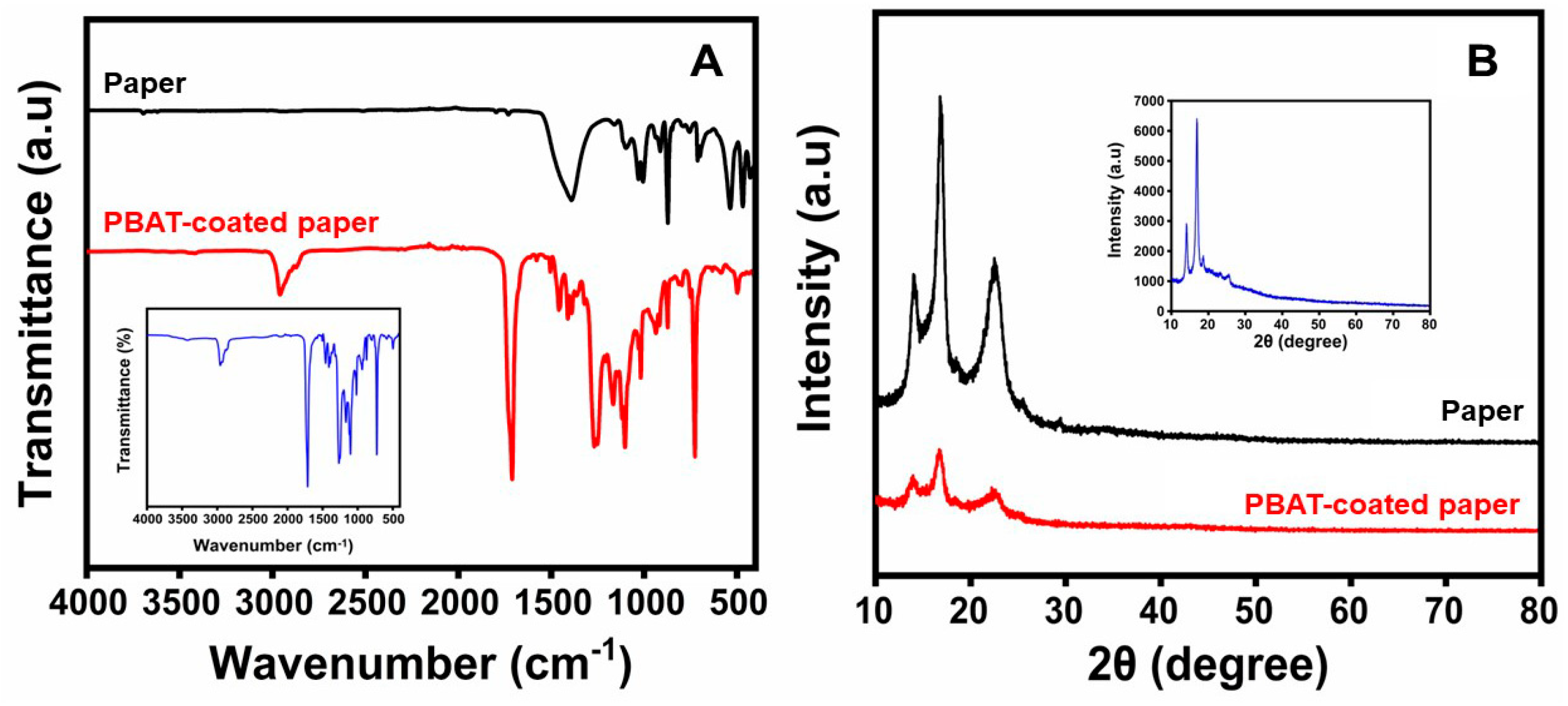
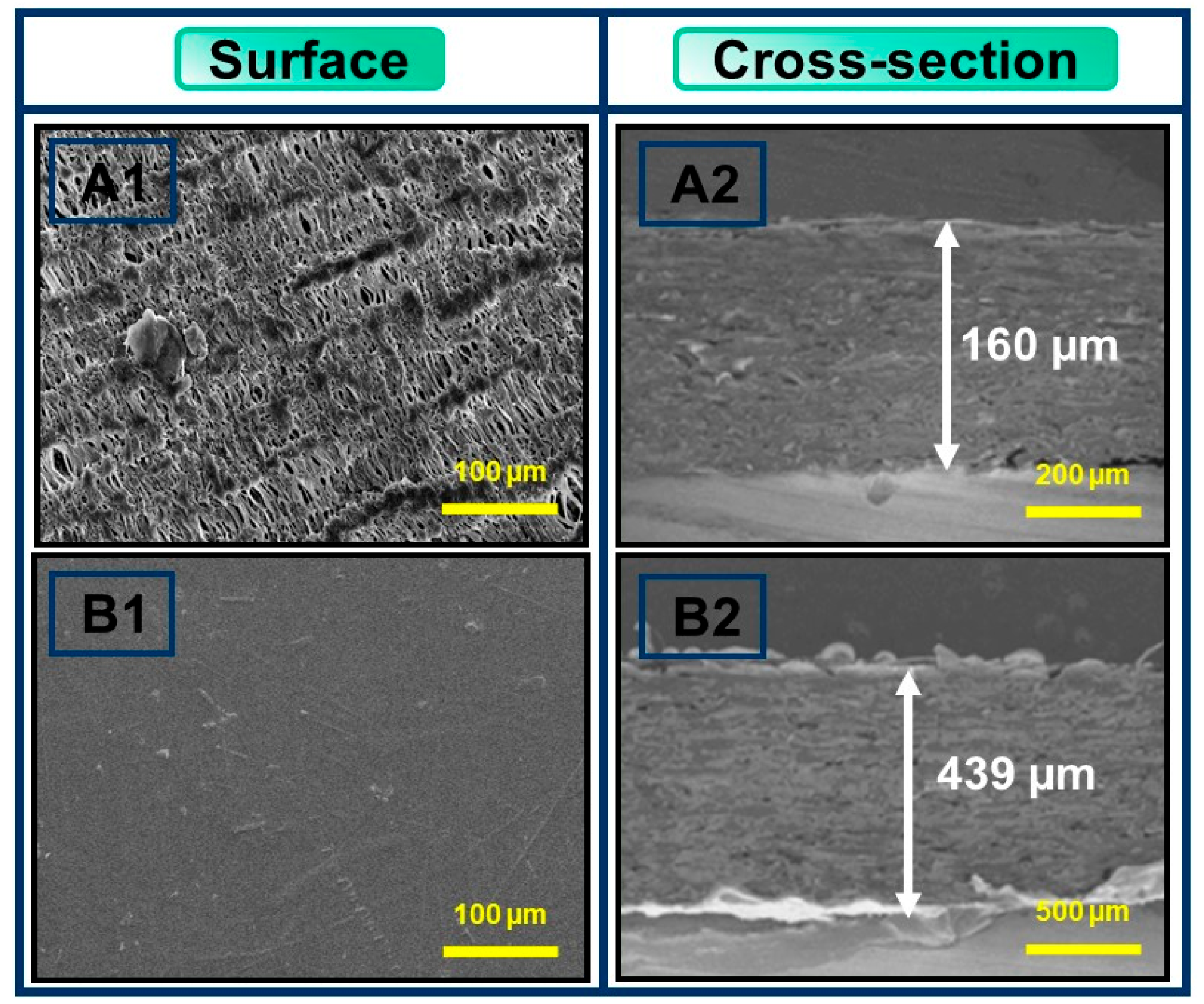


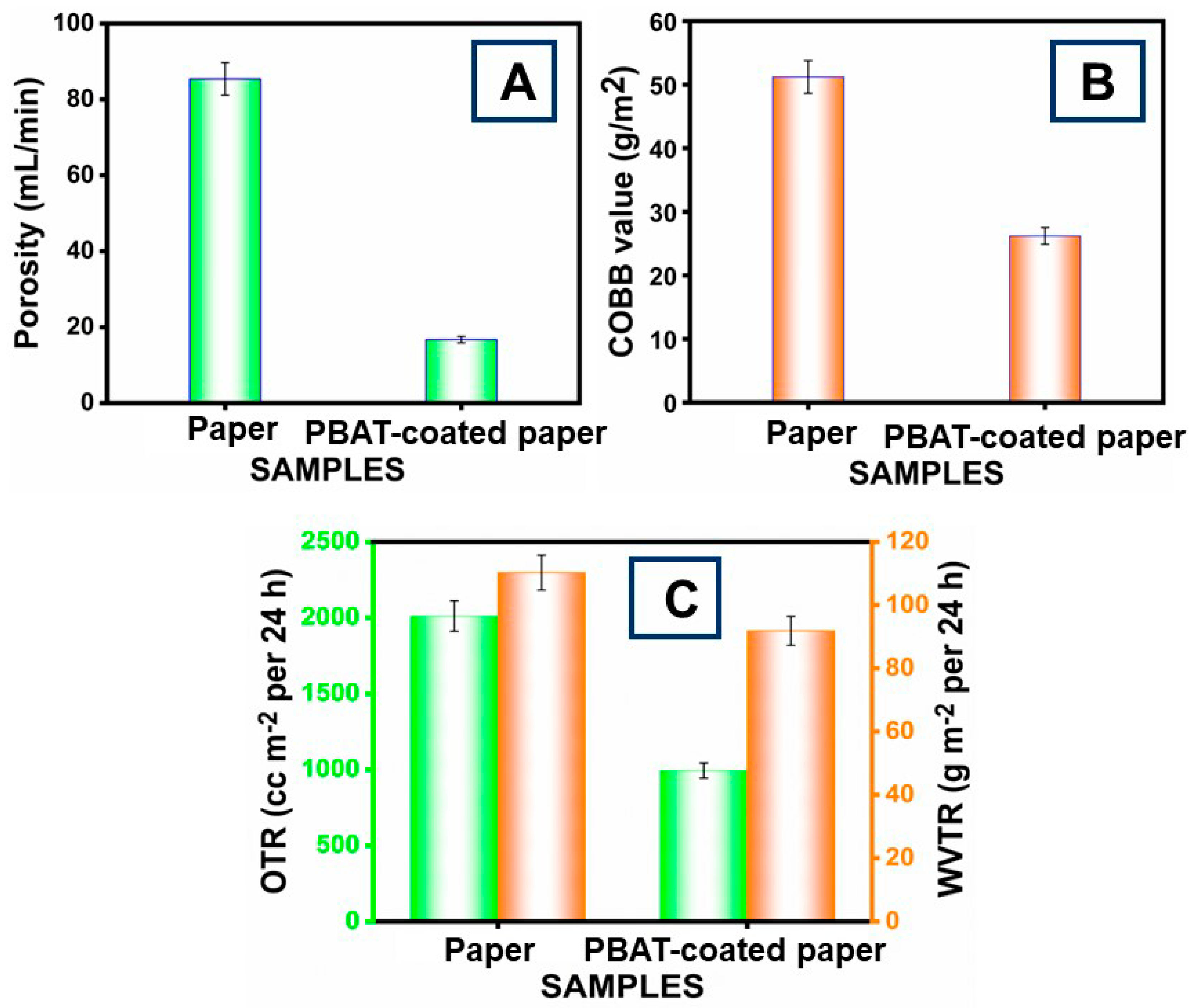
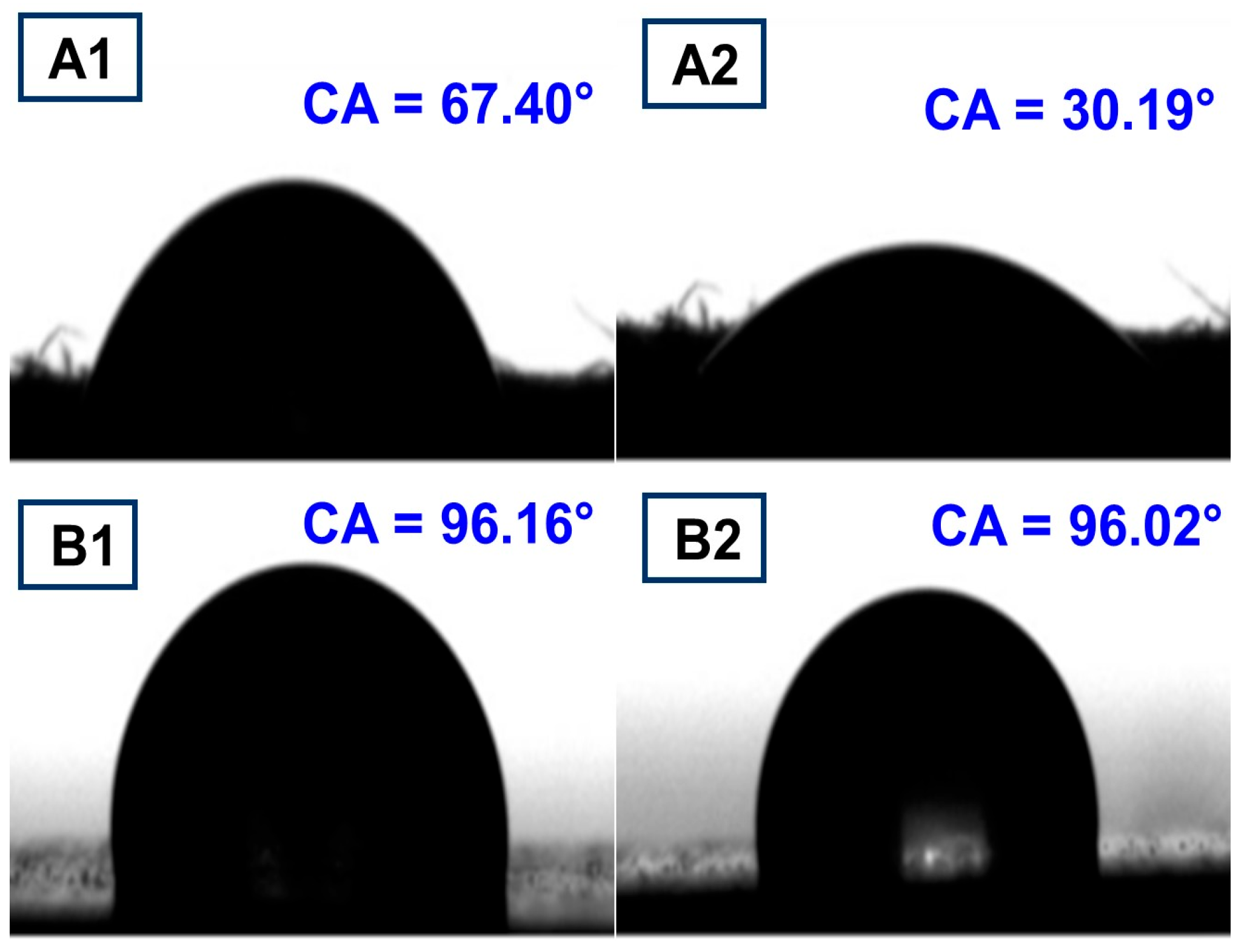

| S. No. | Properties | Paper | PBAT-Coated Paper |
|---|---|---|---|
| 1. | Grammage (g/m2) | 180 ± 5.1 | 197.0 ± 9.0 |
| 2. | Thickness (µm) | 160 ± 2.0 | 439.4 ± 6.0 |
| 3. | Density (g/cm3) | 0.645 | 0.916 |
| 4. | Bendtsen permeability (mL/min) | 130 ± 20 | 0 |
| 5. | Water angle contact (°) | 72.3 ± 1.0 | 96.1 ± 1.2 |
| S. No. | Days | Weight Loss (g) | ||
|---|---|---|---|---|
| Control (Open Air) | Paper | PBAT Coated Paper | ||
| 1. | 1 | 79.437 | 72.621 | 80.534 |
| 2. | 3 | 76.454 | 70.079 | 80.102 |
| 3. | 6 | 75.722 | 69.612 | 79.708 |
| 4. | 9 | 73.098 | 67.887 | 79.091 |
| 5. | 14 | 62.192 | 57.220 | 75.891 |
| S. No. | Parameters | Day 1 | Control (Open Air) on Day 14 | Paper on Day 14 | Coated Paper on Day 14 |
|---|---|---|---|---|---|
| 1. | Weight (g) | Control (open air)—79.437 | 62.192 | 57.220 | 75.891 |
| Paper—72.621 | |||||
| Coated paper—80.534 | |||||
| 2. | Color | Dark red | Pale red | Pale red | Pale red |
| 3. | Odor | Satisfactory | Malodorous | Average | Acceptable |
| 4. | Firmness | Firm | Soggy | Soft and soggy | Soft |
Disclaimer/Publisher’s Note: The statements, opinions and data contained in all publications are solely those of the individual author(s) and contributor(s) and not of MDPI and/or the editor(s). MDPI and/or the editor(s) disclaim responsibility for any injury to people or property resulting from any ideas, methods, instructions or products referred to in the content. |
© 2024 by the authors. Licensee MDPI, Basel, Switzerland. This article is an open access article distributed under the terms and conditions of the Creative Commons Attribution (CC BY) license (https://creativecommons.org/licenses/by/4.0/).
Share and Cite
Venkatesan, R.; Alagumalai, K.; Vetcher, A.A.; Al-Asbahi, B.A.; Kim, S.-C. Eco-Friendly Poly (Butylene Adipate-co-Terephthalate) Coated Bi-Layered Films: An Approach to Enhance Mechanical and Barrier Properties. Polymers 2024, 16, 1283. https://doi.org/10.3390/polym16091283
Venkatesan R, Alagumalai K, Vetcher AA, Al-Asbahi BA, Kim S-C. Eco-Friendly Poly (Butylene Adipate-co-Terephthalate) Coated Bi-Layered Films: An Approach to Enhance Mechanical and Barrier Properties. Polymers. 2024; 16(9):1283. https://doi.org/10.3390/polym16091283
Chicago/Turabian StyleVenkatesan, Raja, Krishnapandi Alagumalai, Alexandre A. Vetcher, Bandar Ali Al-Asbahi, and Seong-Cheol Kim. 2024. "Eco-Friendly Poly (Butylene Adipate-co-Terephthalate) Coated Bi-Layered Films: An Approach to Enhance Mechanical and Barrier Properties" Polymers 16, no. 9: 1283. https://doi.org/10.3390/polym16091283
APA StyleVenkatesan, R., Alagumalai, K., Vetcher, A. A., Al-Asbahi, B. A., & Kim, S.-C. (2024). Eco-Friendly Poly (Butylene Adipate-co-Terephthalate) Coated Bi-Layered Films: An Approach to Enhance Mechanical and Barrier Properties. Polymers, 16(9), 1283. https://doi.org/10.3390/polym16091283









